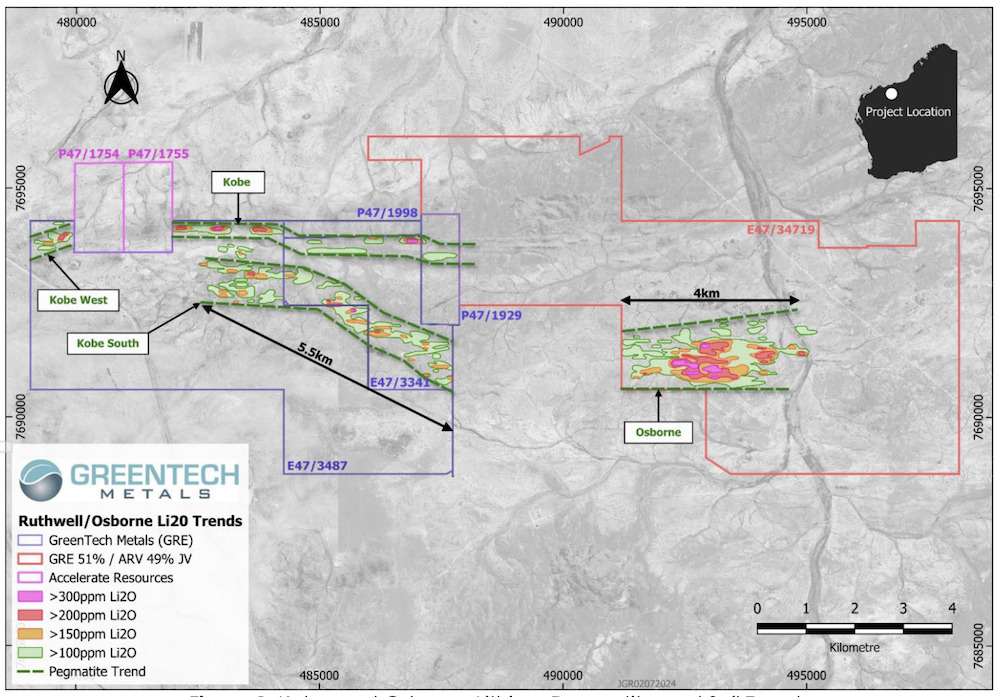GreenTech measures up strong 5.5km lithium trend at Kobe South

GreenTech has high grade zones to target for upcoming drilling. Pic via Getty Images.
- Kobe South pegmatite trend now 5.5km-long with up to 467ppm Li2O in soils
- Osborne pegmatite cluster defined by large lithium soil footprint with up to 712ppm Li2O
- Initial drill testing of high-grade zones planned
Special Report: Soil samples taken from GreenTech Metals’ Ruth Well and Osborne JV projects have confirmed Kobe South as a strong 5.5km-long lithium pegmatite trend and further expanded the anomalous lithium soil footprint at Osborne.
Battery minerals explorer GreenTech Metals’ (ASX:GRE) Ruth Well and Osborne JV is nestled in the West Pilbara’s world-class lithium district near SQM and Hancock Prospecting’s Andover project, a Tier-1 discovery which transformed one-time exploration minnow Azure Minerals into a $1.7b takeover target this year.
It is the sort of transformation GreenTech and Artemis are hoping to see from their own prospects if they can find the motherlode.
GreenTech is progressing the Osborne JV (51% GRE: 49% ARV) with West Pilbara neighbour Artemis Resources (ASX:ARV).
Lithium trends further defined
A follow-up in-fill soil program was focused on the Ruth Well and Osborne JV tenements to better define lithium soil anomalies highlighted by samples Artemis took in 2018.
The Kobe South trend is a western extension of the very strong lithium soil footprint associated with the identified Osborne pegmatite cluster and soil sampling has confirmed a 5.5km-long strike that varies in width from 300m up to 1km.
GreenTech says it’s considered to likely represent a western extension to the Osborne cluster which is exposed at surface and located 3.4km to the east within the Osborne JV tenement.
Kobe West represents the extreme western extension of the Kobe trend, defined with a strike of 700m and a width of 200m, with peak assays exceeding 200ppm.
Accelerate Resources (ASX:AX8), which holds the adjoining tenement, reported strong lithium-caesium soil anomalism within their tenements between the Kobe-Kobe West trend which, when combined, gives a lithium mineralised strike of at least 9.5km.
The Osborne cluster of pegmatites is defined by a large associated anomalous lithium soil footprint which has a strike of ~4km and a width of up to 1.3km.
Its anomalous footprint eclipses the size of the observed pegmatite outcrop and indicates there is potentially more to be discovered at Osborne.
The soils report a peak assay of 712ppm Li2O and with numerous Li2O assays >300ppm.

“We are pleased to see the persistence of well-defined lithium soil anomalies along strike at our Ruth Well and Osborne JV projects,” GreenTech executive director Tom Reddicliffe says.
“These results are supported by the discovery of additional pathfinder elements which are consistent with other anomalies associated with a nearby lithium bearing pegmatite.
It is also very encouraging that the tenor of the anomalies is similar to that of other soil anomalies associated with known lithium pegmatite occurrences in other parts of our project area.
These results give us considerable confidence that GreenTech can continue to make further exciting lithium discoveries within the region.”
What’s next?
GreenTech says the lithium soil trends are now sufficiently defined to allow initial drill testing of the higher-grade zones, aimed at identifying associated pegmatite bodies.
While some lithium soil trends have been partially cleared by previous heritage surveys, additional surveys are planned to ensure all targeted areas are covered.
This article was developed in collaboration with GreenTech Metals, a Stockhead advertiser at the time of publishing.
This article does not constitute financial product advice. You should consider obtaining independent advice before making any financial decisions.
Related Topics

UNLOCK INSIGHTS
Discover the untold stories of emerging ASX stocks.
Daily news and expert analysis, it's free to subscribe.
By proceeding, you confirm you understand that we handle personal information in accordance with our Privacy Policy.








